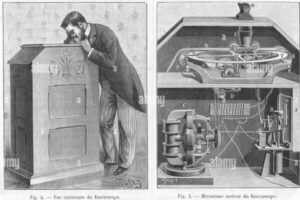Medical imaging plays a crucial role in the diagnosis of various diseases. It allows healthcare professionals to visualize the internal structures of the body and identify abnormalities or injuries. Among the many imaging techniques available, the Magnetic Resonance Imaging (MRI) machine stands out as a revolutionary advancement in the field.
The MRI machine, with its ability to produce detailed cross-sectional images of the body, has transformed medical diagnosis and research. However, it is surprising to learn that this innovative technology was initially overlooked and overshadowed by other medical innovations.
Table of Contents
Importance of Medical Imaging
Medical imaging has become an essential tool in modern healthcare. It enables doctors to accurately diagnose diseases, plan treatments, and monitor the progress of patients. By providing detailed images of the body’s internal structures, medical imaging aids in the early detection of conditions such as cancer, cardiovascular diseases, and neurological disorders.
The Revolutionary Advancement: MRI
The Magnetic Resonance Imaging (MRI) machine is a remarkable development in medical imaging. It harnesses the power of magnetic fields and radio waves to generate high-quality, three-dimensional images of the body’s tissues and organs. Unlike other imaging techniques, MRI does not use ionizing radiation, making it safer for patients, especially for those who require repeated imaging studies.
The MRI machine offers several advantages over traditional imaging methods. It provides exceptional soft tissue contrast, making it exceptionally useful in diagnosing conditions of the brain, spinal cord, and joints. MRI is also valuable in assessing the health of organs like the heart, liver, and kidneys. Moreover, it can detect abnormalities in blood vessels and aid in the early diagnosis of cardiovascular diseases.
Initial Lack of Recognition
Despite its significant advantages, the MRI machine faced an initial lack of recognition and was overshadowed by other medical innovations. Techniques such as X-rays and CT scans, which had been more established and widely used, received more attention. Moreover, the limited availability of MRI machines due to their high cost and technical complexity hindered their widespread adoption.
It is surprising to realize that the potential impact of Magnetic Resonance Imaging on medical diagnosis and research was initially underestimated. However, over time, as the capabilities and advantages of MRI became more evident, it slowly started gaining recognition as a powerful imaging tool.
Overall, the initial lack of recognition and overshadowing of the MRI machine by other medical innovations highlights the importance of acknowledging and appreciating advancements in medical technology. It serves as a reminder of the need to continuously explore and support further innovation in the field of medical imaging, as it can have a profound impact on the diagnosis and treatment of various diseases.
Early Days of Medical Imaging
Medical imaging has played a crucial role in diagnosing diseases, revolutionizing the field of medicine. The emergence of X-rays was the first step towards visualizing the internal structures of the human body and detecting abnormalities. X-rays brought a significant breakthrough in medical diagnosis, allowing doctors to identify fractures, tumors, and other conditions that were previously difficult to detect. This innovation marked a turning point in medical history, highlighting the importance of visualizing the internal structures for accurate diagnoses.
Following the success of X-rays, the development of CT scans further enhanced medical imaging capabilities. These scans provided a more detailed picture of the body, enabling identification of internal injuries and diseases with greater accuracy. CT scans played a crucial role in the early detection of life-threatening conditions, such as cancer and cardiovascular diseases. The ability to swiftly and accurately diagnose these conditions significantly improved patient outcomes.
As medical imaging continued to evolve, another significant advancement came in the form of ultrasound technology. This non-invasive imaging technique allowed doctors to visualize internal organs and even unborn babies. The introduction of ultrasound made it possible to monitor the growth and development of fetuses, ensuring the well-being of both the mother and the baby. Moreover, ultrasound became an essential tool in diagnosing conditions affecting various organs, such as the kidney and liver.
These early developments in medical imaging set the stage for the birth of a groundbreaking technology: the Magnetic Resonance Imaging (MRI) machine.
The Birth of MRI
Magnetic Resonance Imaging (MRI) is a groundbreaking medical imaging technology that has revolutionized the field of diagnostic medicine. The principles behind MRI involve the use of strong magnetic fields and radio waves to create detailed images of the body’s internal structures.
The development of MRI technology can be credited to a group of pioneers who recognized the potential of harnessing the power of magnetic resonance for medical imaging. Among them, Paul Lauterbur and Peter Mansfield were instrumental in developing the methods and techniques that paved the way for the creation of the MRI machine.
In its early days, MRI faced several challenges. The technology was highly complex and required a significant amount of technical expertise to implement and operate. Additionally, the cost of MRI machines was prohibitively high, making them inaccessible to many medical institutions. These factors, combined with the lack of awareness about the potential applications of MRI, resulted in its initial overshadowing by other medical innovations such as X-rays and CT scans.
However, as time passed and more research was conducted, the true capabilities of MRI began to emerge. Medical professionals and researchers started recognizing the unique advantages that MRI offered over other imaging techniques. MRI provided detailed anatomical images without the use of ionizing radiation, making it safer for patients, particularly children and pregnant women. Moreover, MRI allowed for the visualization of soft tissues, such as the brain, muscles, and organs, with unprecedented clarity.
As the potential of MRI became more widely known, efforts were made to make the technology more accessible. The size and complexity of the machines were reduced, making them more affordable and easier to operate. This evolution of MRI machines led to their widespread availability, enabling medical institutions to adopt this innovative technology and incorporate it into their diagnostic practices.
The development of MRI technology and its increasing applications have transformed the field of medical imaging. MRI is now used in various medical fields, including oncology, neurology, and cardiology, for the diagnosis and monitoring of a wide range of conditions. Ongoing research and innovations continue to enhance the capabilities of MRI, making it increasingly valuable in research and clinical settings.
In conclusion, the birth of the MRI machine marks a significant milestone in the history of medical imaging. Despite its early overshadowing and limited accessibility, MRI has emerged as a game-changing technology with vast potential for diagnosis and research. Recognition and appreciation of such advancements in medical technology are vital for further innovation in the field of medical imaging.
The Overshadowed Innovation
The Magnetic Resonance Imaging (MRI) machine has been a remarkable breakthrough in the field of medical imaging, revolutionizing the way diseases are diagnosed and treated. However, it is surprising to learn that such an incredible innovation was initially overlooked and overshadowed by other medical advancements like X-rays and CT scans.
During the early days of medical imaging, X-rays emerged as a groundbreaking technology that allowed physicians to visualize the internal structures of the human body. They quickly gained popularity due to their effectiveness in diagnosing various conditions. Soon after, CT scans were introduced, further enhancing the ability to identify internal injuries and diseases. These advancements, while undoubtedly valuable, somewhat overshadowed the potential of MRI.
One of the primary reasons why MRI machines were initially overlooked was their limited availability. These machines were not as widely accessible as X-ray and CT scan machines due to their high cost and complexity. The immense technical requirements and substantial investment hindered their widespread adoption, preventing many medical professionals from fully appreciating the potential impact of MRI on medical diagnosis and research.
The underappreciation of MRI’s potential is truly unfortunate, as this technology has proven to be invaluable in medical imaging. MRI provides detailed and precise images of the body, allowing for the visualization of soft tissues, such as organs, muscles, and nerves, with unparalleled clarity. Moreover, the non-invasive nature of MRI makes it a preferred choice for patients, minimizing the risks associated with invasive procedures.
Fortunately, over time, the true potential of MRI was recognized, leading to its widespread adoption and recognition. As technology advanced, MRI machines became more compact, affordable, and widely available. These developments allowed for the expansion of MRI applications in various medical fields and research areas. Today, MRI plays a crucial role in diagnosing diseases such as cancer, neurological disorders, and cardiovascular conditions, providing physicians with essential information for accurate diagnoses and treatment plans.
Looking into the future, ongoing research and innovations continue to enhance MRI technology and its application. Scientists and engineers are working to improve the resolution and speed of MRI machines, making diagnosis even more accurate and efficient. Additionally, there are potential areas of future development, such as functional MRI, which can provide insights into brain activity, and molecular imaging, which aims to visualize specific molecules in the body for early disease detection.
In conclusion, the early years of MRI were marked by overshadowing and underappreciation, as this remarkable technology faced limitations in availability and recognition. However, with growing recognition of its capabilities and widespread adoption, MRI has proven to be an invaluable tool in medical diagnosis and research. It is crucial to acknowledge and appreciate advancements in medical technology like the MRI machine and encourage further innovation in the field of medical imaging.
Recognition and Widespread Adoption
The recognition of the capabilities and advantages of MRI over other imaging techniques has been steadily growing in the medical community. As more research and experience have been accumulated, it has become increasingly clear that MRI offers unique insights into the human body that cannot be easily obtained through other imaging modalities.
The evolution of MRI machines has also played a significant role in their widespread adoption. From their early days as large, expensive, and limited-use equipment, MRI machines have transformed into compact, affordable, and widely available devices. This transformation has made MRI accessible to a broader range of medical facilities and patients, leading to its increased usage.
The applications of MRI have expanded beyond initial expectations, covering various medical fields and research areas. MRI’s ability to provide highly detailed and accurate images of soft tissues, such as the brain, spine, and joints, has made it indispensable in fields like neurology, orthopedics, and oncology. Furthermore, ongoing advancements in MRI technology continue to uncover new possibilities for diagnosis and treatment in these and other medical disciplines.
The growing recognition and usage of MRI in medical practice have been instrumental in driving further innovation and research in this field. As the medical community continues to explore the intricacies of MRI, researchers are finding new ways to enhance its capabilities. These include improving image resolution, reducing scan times, and developing specialized MRI techniques for specific medical conditions.
In conclusion, the recognition and widespread adoption of the Magnetic Resonance Imaging machine have revolutionized the practice of medical imaging. MRI’s unparalleled capabilities and advantages over other techniques have led to its evolution from a limited-use and expensive technology to a compact, affordable, and widely available tool. Its expanding applications in various medical fields and ongoing innovations promise an even more impactful future for MRI in medical diagnosis and research. The growing recognition of MRI’s potential should encourage support for further innovation and exploration in the field of medical imaging.
Current Impact and Future Innovations
The Magnetic Resonance Imaging (MRI) machine has had an invaluable role in diagnosing various diseases, ranging from cancer to neurological disorders and cardiovascular conditions. Its ability to produce detailed images of the inside of the body has revolutionized the field of medical imaging.
The current impact of MRI technology is evident in its widespread use in hospitals and clinics worldwide. The non-invasive nature of MRI scans allows doctors to detect and diagnose diseases without the need for invasive procedures or surgeries. This has significantly improved patient outcomes and reduced the risks associated with traditional diagnostic methods.
Moreover, MRI machines are not just limited to diagnosis alone. Ongoing research and innovations are continuously pushing the boundaries of MRI technology, making it an increasingly powerful tool in the medical field. For instance, researchers are exploring the use of MRI to monitor and track the progression of diseases over time, enabling more personalized and targeted treatment plans.
Furthermore, future developments in the field of Magnetic Resonance Imaging hold immense potential. There is a growing interest in improving the speed and resolution of MRI scans, allowing for even more precise and accurate diagnoses. Additionally, the integration of artificial intelligence and machine learning algorithms into MRI analysis has the potential to further enhance the diagnostic capabilities of the technology.
In conclusion, the MRI machine has made an undeniable impact in the medical field, allowing for the timely and accurate diagnosis of various diseases. As ongoing research and innovations continue to enhance the technology, we can expect even greater advancements in the field of Magnetic Resonance Imaging. It is crucial to recognize and support these innovations to further improve medical imaging and ultimately, patient care.
Conclusion
The Magnetic Resonance Imaging (MRI) machine serves as a remarkable example of an early overlooked innovation in the field of medical technology. Despite its revolutionary potential for diagnosing various diseases, the MRI machine initially struggled to gain recognition and attention compared to other imaging techniques.
Reflecting on this oversight, it becomes clear that advancements in medical technology should not be underestimated or overshadowed by more established methods. The importance of recognizing and appreciating these breakthroughs cannot be overstated, as they have the potential to significantly transform the field of medicine.
In the case of the MRI machine, its development and widespread adoption were hindered by factors such as limited availability due to high costs and complexity. At first, the potential of MRI technology was underappreciated, and it was overshadowed by the popularity of X-rays and CT scans. However, as its capabilities became more recognized, the MRI machine started to gain traction and overcome these obstacles.
Fortunately, with advancements in technology, MRI machines have evolved from large, expensive, and limited-use equipment to more compact, affordable, and widely accessible devices. The growing recognition of MRI’s advantages over other imaging techniques has led to its expanding applications in various medical fields and research areas.
The current impact of MRI technology on medical diagnosis is invaluable. It plays a crucial role in diagnosing diseases such as cancer, neurological disorders, and cardiovascular conditions. Ongoing research and innovations continue to enhance MRI technology, providing new possibilities for diagnosis and treatment. Future developments in the field of Magnetic Resonance Imaging hold promising potential, with advancements like higher-resolution imaging, faster scanning times, and more specialized applications.
In conclusion, the overlooked innovation of the Magnetic Resonance Imaging machine highlights the need to recognize and appreciate advancements in medical technology. As individuals, it is vital to support and explore further innovation in the field of medical imaging, ultimately leading to improved healthcare and better patient outcomes. By embracing and advocating for these advancements, we can contribute to the advancement of medical science and the well-being of society as a whole.




